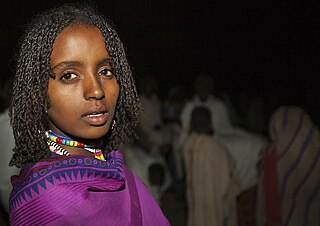
The Oromo people are a Cushitic ethnic group native to the Oromia region of Ethiopia and parts of Northern Kenya. They speak the Oromo language, which is part of the Cushitic branch of the Afroasiatic language family. They are one of the largest ethnic groups in Ethiopia. According to the last Ethiopian census of 2007, the Oromo numbered 25,488,344 people or 34.5% of the Ethiopian population. Recent estimates have the Oromo comprising 45,000,000 people, or 35.8% of the total Ethiopian population estimated at 116,000,000.
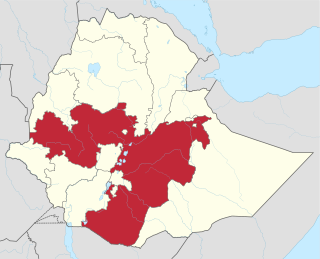
Oromia is a regional state in Ethiopia and the homeland of the Oromo people. Under Article 49 of Ethiopian Constitution, the capital of Oromia is Addis Ababa, also called Finfinne. The provision of the article maintains special interest of Oromia by utilizing social services and natural resources of Addis Ababa.
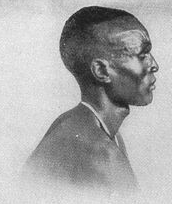
The Dinka people are a Nilotic ethnic group native to South Sudan. The Dinka mostly live along the Nile, from Mangalla-Bor to Renk, in the region of Bahr el Ghazal, Upper Nile, and the Abyei Area of the Ngok Dinka in South Sudan.

Benishangul-Gumuz is a regional state in northwestern Ethiopia bordering Sudan. It was previously known as Region 6. The region's capital is Assosa. Following the adoption of the 1995 constitution, the region was created from the westernmost portion of the Gojjam province, and the northwestern portion of the Welega Province. The name of the region comes from two peoples – Berta and Gumuz.

The Koman languages are a small close-knit family of languages located along the Ethiopia–Sudan border with about 50,000 speakers. They are conventionally classified as part of the Nilo-Saharan family. However, due to the paucity of evidence, many scholars treat it as an independent language family. Among scholars who do accept its inclusion within Nilo-Saharan, opinions vary as to their position within it.

The languages of Ethiopia include the official languages of Ethiopia, its national and regional languages, and a large number of minority languages, as well as foreign languages.
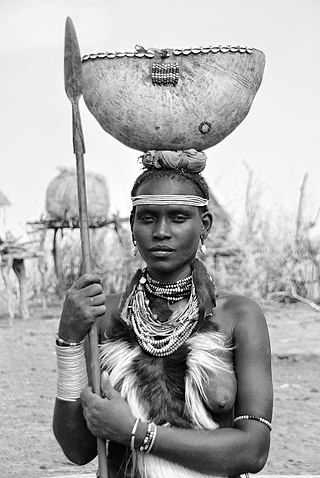
The Daasanach are an ethnic group inhabiting parts of Ethiopia, Kenya, and South Sudan. Their main homeland is in the Debub Omo Zone of the Southern Nations, Nationalities, and People's Region, adjacent to Lake Turkana. According to the 2007 national census, they number 48,067 people, of whom 1,481 are urban dwellers.

The Gumuz are an ethnic group speaking a Nilo-Saharan language inhabiting the Benishangul-Gumuz Region in western Ethiopia, as well as the Fazogli region in Sudan. They speak the Gumuz language, which belongs to the Nilo-Saharan family. The Gumuz number around 250,000 individuals.
Mao-Komo is a woreda in Benishangul-Gumuz Region, Ethiopia. Because it is not part of any zones in Benishangul-Gumuz, it is considered a Special woreda, an administrative subdivision which is similar to an autonomous area. The southernmost woreda in the Region, Mao-Komo is bordered on the west by Sudan and South Sudan, on the north by the Assosa Zone, and on the east and south by the Oromia Region. Towns in this woreda include Tongo, which has a weekly market. The Tongo refugee camp, housing 12,483 displaced people from Sudan and South Sudan, is also located in Mao-Komo.

Tella or talla is a traditional beer from Ethiopia. It is brewed from various grains, which can change depending on location. These typically include barley or teff. Depending on region, wheat, sorghum, or corn may be used; spices can also be added. Dried and ground shiny-leaf buckthorn leaves are used for fermentation. The drink is made in a clay pot. The pot is washed with a plant called grawa. After rinsing it is smoked with weyra or Abyssinian rose. The alcohol content of tella is usually around 2–4 volume percent.
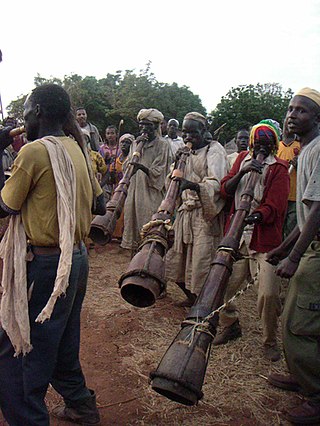
The Berta (Bertha) or Funj or Benishangul are an ethnic group living along the border of Sudan and Ethiopia. They speak a Nilo-Saharan language that is not related to those of their Nilo-Saharan neighbors. The total population of Ethiopian-Bertas in Ethiopia is 208,759 people. Sudanese-Bertas number around 180,000.
Hozo is an Afroasiatic language spoken mostly in the Kondala woreda of Mirab Welega Zone by peoples generically known as "Mao". There are smaller groups of Hozo speakers in Mana Sibu woreda. The term Hozo is usually understood by the Mao to refer to a clan. Hozo speakers prefer to call themselves Amo. Hozo and Seze are sometimes called Begi Mao. Hozo is spoken by roughly 3,000 people in Ethiopia. Hozo is also a clan in the Begi area. The Hozo language is also known as Begi-Mao and Mao of Begi. Its classification is Afro-Asiatic, Omotic, and Mao. The word Mao is Omotic and means ‘man; people’, occurring as [ma:ɪ] in Seze and as [mɔ:] in Hozo. Mao is frequently used as an ethnic term. There is a kind of Mao identity across language differences in Ethiopia. While it is generally accepted today that Omotic is one of the primary branches of the Afro-Asiatic family, the position of the four languages Hozo, Seze, Ganza and Northern Mao is still being discussed. The Mao languages are the least documented within Omotic, and Omotic itself is the least documented of the Afroasiatic groups.
Komo is a Nilo-Saharan language spoken by the Kwama (Komo) people of Ethiopia, Sudan and South Sudan. It is a member of the Koman languages. The language is also referred to as Madiin, Koma, South Koma, Central Koma, Gokwom and Hayahaya. Many individuals from Komo are multilingual because they are in close proximity to Mao, Kwama and Oromo speakers. Komo is closely related to Kwama, a language spoken by a group who live in the same region of Ethiopia and who also identify themselves as ethnically Komo. Some Komo and Kwama speakers recognize the distinction between the two languages and culture, whereas some people see it as one "ethnolinguistic" community. The 2007 Ethiopian census makes no mention of Kwama, and for this reason its estimate of 8,000 Komo speakers may be inaccurate. An older estimate from 1971 places the number of Komo speakers in Ethiopia at 1,500. The Komo language is greatly understudied; more information is being revealed as researchers are discovering more data about other languages within the Koman family.

The Konso, also known as the Xonsita, are a Lowland East Cushitic-speaking ethnic group primarily inhabiting south-western Ethiopia.
The Mao languages are a branch of the Omotic languages spoken in Ethiopia and parts of Sudan. The group had the following categories:

Sudanese cuisine is greatly affected by the historical cross-cultural influences of Arab, Nubian, Egyptian, Turkish, and Levantine cuisine in Sudan. Many Sudanese foods have been around for thousands of years. The most common meats eaten are lamb and chicken, in accordance with the Muslim halal laws. Most meals are communal and often shared with family, neighbors, and guests, as part of Sudanese hospitality.
Kwama is a Koman language, spoken in the South Benishangul-Gumuz region of Ethiopia, along the Sudan border between Asosa and Gidami.
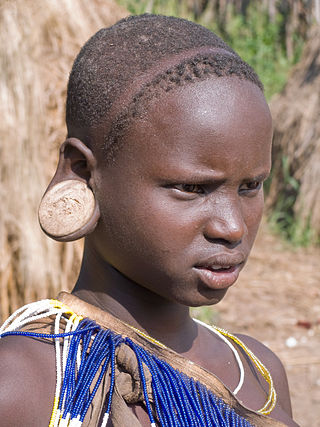
Suri is a collective name for three ethnic groups mainly living in Suri woreda, in southwestern Ethiopia. They share many similarities politically, territorially, culturally and economically but speak different languages. They all speak South East Surmic languages within the Nilo-Saharan language family, which includes the Mun, Majang, and Me'en people's languages.

South Sudan is home to around 60 indigenous ethnic groups and 80 linguistic partitions among a 2021 population of around 11 million. Historically, most ethnic groups were lacking in formal Western political institutions, with land held by the community and elders acting as problem solvers and adjudicators. Today, most ethnic groups still embrace a cattle culture in which livestock is the main measure of wealth and used for bride wealth.

The Benishangul-Gumuz conflict was an armed conflict mostly in the Metekel Zone of the Benishangul-Gumuz Region in Ethiopia that started in 2019, until peace agreement signed between the rebel groups and the government of Ethiopia in October 2022.













